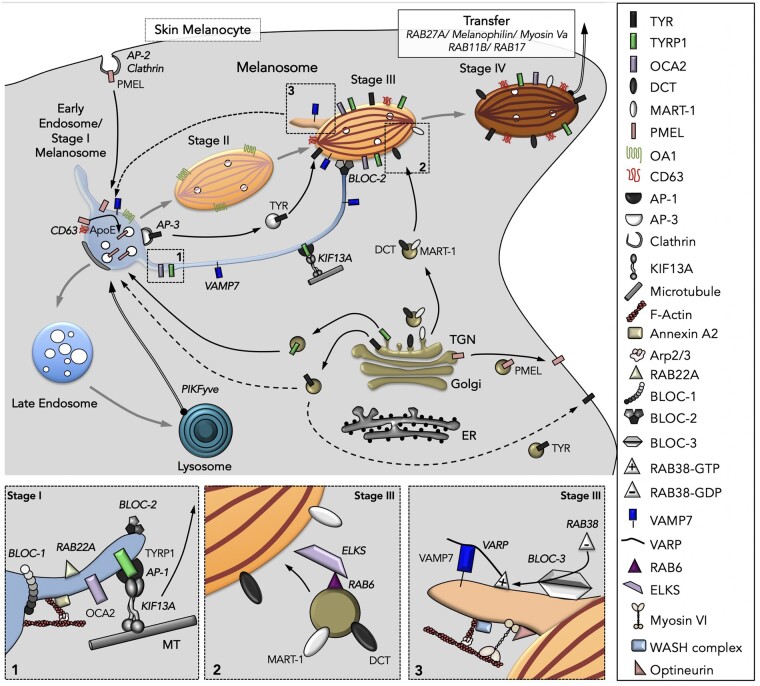Fig. 3.
Working model of intracellular trafficking during melanosome biogenesis. Key molecules indicated in the figure are shown to the right. All melanosomal proteins are synthesized in the ER and transit the Golgi complex and the TGN en route to melanosomes. Transport of cargoes such as TYR, TYRP1, and DCT between compartments from the TGN and beyond are indicated by solid (if known) or dashed (if not yet determined) black arrows. The early endosome/Stage I melanosome progressively matures (gray arrows) to late endosomes and lysosomes or to Stage IV pigmented melanosomes through the sequential delivery of components that originate from the endocytic and exocytic pathways. PMEL is targeted from the TGN to the plasma membrane, from where it is endocytosed PMEL and delivered to Stage I melanosomes. It is then sorted to ILVs, from which it forms elongated amyloid fibrils that distend the organelle to form Stage II melanosomes. This process requires CD63, OA1, Apoliprotein E (ApoE), and other effectors described in the text. Melanin synthesis begins in Stage III due to the delivery of TYR, TYRP1, OCA2, ATP7A, and other cargoes from endosomes/Stage I melanosomes—to which TYRP1 is delivered without passing through the cell surface—and of DCT and MART-1 from the Golgi/TGN. Two transport pathways originate from Stage I melanosomes, a vesicular route requiring AP-3 and a tubular route (box 1) requiring BLOC-1, AP-1, RAB22A, KIF13A, microtubules, and branched actin-associated machineries for tubule formation. The tubules are targeted along microtubules toward maturing Stage III melanosomes in a process requiring BLOC-2, and fuse with these organelles in a VAMP7-dependent manner. A third route (box 2) is mediated by secretory-like vesicles bearing MART-1 and DCT that bud from the Golgi apparatus/TGN in a process requiring RAB6 and are targeted toward maturing Stage III melanosomes in an ELKS-dependent manner. From Stage III melanosomes, some components (e.g., VAMP7 bound to the scaffolding protein VARP) are removed (box 3) via membrane tubules that require BLOC-3, RAB38/RAB32, Myosin VI, OPTN, the WASH complex, and branched actin filaments to promote their formation and release; these tubules might be transported to Stage I melanosomes (dashed arrow). Stage IV melanosomes require the tripartite complex RAB27A, Melanophilin, Myosin Va, and other RAB GTPases to tether to the peripheral actin cytoskeleton prior to transfer to keratinocytes, a poorly understood process that is detailed in the companion paper in this issue (Benito-Martinez et al. 2021). Adapted from Bowman et al. (2019) and Delevoye et al. (2019).

